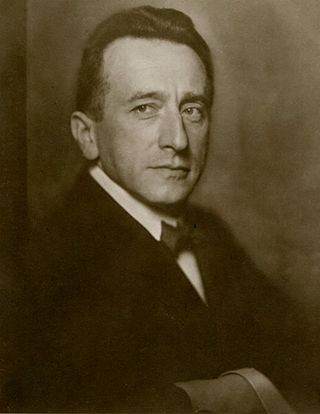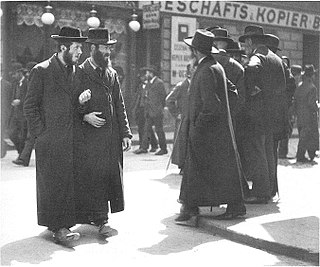Related Research Articles

Melvin Jonah Lasky was an American journalist, intellectual, and member of the anti-Communist left. He founded the German journal Der Monat in 1948 and, from 1958 to 1991, edited Encounter, one of many journals revealed to have been secretly funded by the CIA through the Congress for Cultural Freedom (CCF).

Walter Kollo was a German composer of operettas, Possen mit Gesang, and Singspiele as well as popular songs. He was also a conductor and a music publisher.
Internationale Politik (IP) is the magazine of the German Council on Foreign Relations. It covers contemporary topics in international affairs under editor-in-chief Martin Bialecki, who has been in this position since September 2018.

Arbeiter-Illustrierte-Zeitung or AIZ was a German illustrated magazine published between 1924 and March 1933 in Berlin, and afterward in Prague and finally Paris until 1938. Anti-Fascism and pro-Communism in stance, it was published by Willi Münzenberg and is best remembered for the propagandistic photomontages of John Heartfield.

Leo Blech was a German opera composer and conductor who is perhaps most famous for his work at the Königliches Opernhaus from 1906 to 1937, and later as the conductor of Berlin's Städtische Oper from 1949 to 1953. Blech was known for his reliable, clear, and elegant performances, especially of works by Wagner, Verdi, and Bizet's Carmen, and for his sensitivity as an accompanist.
Friedrich Radszuweit was a German manager, publisher, and author and LGBT activist, who was of major importance to the first homosexual movement.

Alfred Polgar was an Austrian-born columnist, theater critic, writer and occasionally translator.
Musikmarkt was a magazine of the music industry in Germany, Austria and Switzerland, based in Munich. Die Welt, a German newspaper, described the magazine as the music industry’s thermometer.
Manfred George, born Manfred Georg Cohn, later shortened to Manfred Georg, was a German journalist, author and translator. He left Germany after the Nazis came to power, living in several different European countries and eventually emigrating penniless to the United States in 1939. He became the editor of Aufbau, a periodical published in German, and transformed it from a small monthly newsletter into an important weekly newspaper, especially during World War II and the postwar era, when it became an important source of information for Jews trying to establish new lives and for Nazi concentration camp survivors to find each other. George remained Editor in Chief of Aufbau until his death.

KUNST Magazin was a nationwide German magazine about ongoing art issues and current exhibitions. It was in circulation between 2006 and 2013.

The Neue Rundschau, formerly Die neue Rundschau, founded in 1890, is a quarterly German literary magazine that appears in the S. Fischer Verlag. With its over 100 years of continuous history, it is one of the oldest cultural publications in Europe.

Kurt Tucholsky was a German journalist, satirist, and writer. He also wrote under the pseudonyms Kaspar Hauser, Peter Panter, Theobald Tiger and Ignaz Wrobel.
Manager Magazin is a German monthly business magazine focusing on business, finance and management based in Hamburg.
Die Freundschaft (Friendship) was a German Weimar-era gay magazine that was published from 1919 to 1933.

Ilse Reicke was a German writer, journalist and feminist.

Die BIF – Blätter Idealer Frauenfreundschaften, subtitled Monatsschrift für weibliche Kultur, was a short-lived lesbian magazine of Weimar Germany, published from either 1925 or 1926 until 1927 in Berlin. Founded by lesbian activist Selli Engler, Die BIF was part of the first wave of lesbian publications in history and the world's first lesbian magazine to be published, edited and written solely by women.
Auguste Lilly Marga Baruch was a German photographer who worked and lived in Berlin in the 1920s.

Maria Kruse (1908–?), better known by her stage name Lea Niako, was a German exotic dancer and actress. Niako was renowned across Europe for her dance performances in the late interwar period, from 1926 to 1933. She often performed with little to no clothes; nude dancing, or Nackttanz, was at the time popular and was seen as an artistic expression of modernity and emancipation. For her unusual and exotic performances, she garnered great attention in the international press. She also broke through into the film industry, appearing in the Portuguese film Fátima Milagrosa (1928) and the Spanish film La Carta (1931).
Koralle was a monthly popular science magazine which appeared in Weimar Republic and then in Nazi Germany between 1925 and 1944. It was one of the publications started by the leading German company Ullstein Verlag. Although it was started as a popular science magazine, it turned into a general interest magazine in 1933 when the Nazi Party began to rule the country.
References
- 1 2 3 "Revue des Monats" (in German). Art Historicum. Retrieved 22 October 2021.
- 1 2 Tim Satterthwaite (2020). Modernist Magazines and the Social Ideal. New York; London: Bloomsbury Publishing. p. 79. ISBN 978-1-5013-4161-8.
- 1 2 3 Valentina Lehmann (2018). Skandal um Eva. Repräsentationen und Imaginationen weiblicher Delinquenz in illustrierten Magazinen der Weimarer Republik (PhD thesis) (in German). Paderborn University. pp. 39–41.
- ↑ "Revue des Monats. 2. Jahrgang Nr. 8 Juni 1928" (in German). ZVAB. Retrieved 22 October 2021.
- ↑ Phoebe Kornfeld (2021). Passionate Publishers: The Founders of the Black Star Photo Agency. Bloomington, IN: Archway Publishing. p. 5-IA64. ISBN 978-1-6657-0905-7.